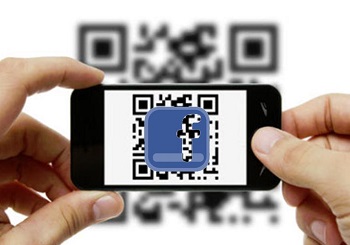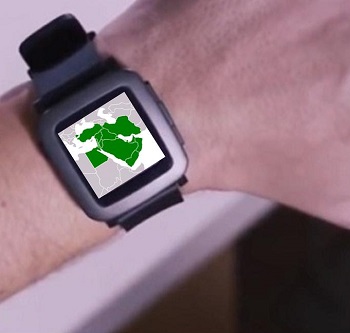The social media giant is now offering new options to help users to be able to connect more conveniently.
Facebook Messenger may not be the most popular mobile messaging application, but it isn’t all that far behind WhatsApp and it has now introduced additional features, including barcodes comparable to QR codes, which are meant to help people to better communicate with their friends and family members…and businesses and brands.
There usage of the mobile app has never been larger, as 900 million people use it every month.
That data is according to Mark Zuckerberg, himself. These days, people use the social network for a great deal more than just posting food pics and cranking about what has happened to them. It has become a very important business tool. It is specifically for this reason that many of the new features such as QR codes have been added to the application. It will make it much easier for businesses to converse with their customers and for people to investigate and communicate with the brands they like.
Among those features are barcodes similar to QR codes, as well as Messenger Links for faster conversation launching.
 The barcodes are actually being called Messenger Codes, although they look just like a redesigned version of a quick response code. On the other hand, the links are just as self-explanatory, as they come in the form of a regular URL that can be tapped in order to begin a conversation over Facebook Messenger. The URLs are designed in the form of m.me/username and are essentially an extension of the traditional vanity URL.
The barcodes are actually being called Messenger Codes, although they look just like a redesigned version of a quick response code. On the other hand, the links are just as self-explanatory, as they come in the form of a regular URL that can be tapped in order to begin a conversation over Facebook Messenger. The URLs are designed in the form of m.me/username and are essentially an extension of the traditional vanity URL.
The Messenger Codes appear to be regular QRcodes but that have undergone a facelift. They can be scanned using the camera of a smartphone or tablet and function as a shortcut into a conversation through the mobile app, instead of having to manually enter any identification info.
Zuckerberg described this take on QR codes by saying that “Messenger Codes let you just pull out your phone and scan someone else’s code — it’s the new circular pattern surrounding their profile photo in Messenger settings. Messenger then starts a conversation with them. No more misspelled names or mistyped phone numbers.”
Companies throughout that region are taking a closer look at wearable technology and are making investments.
Businesses throughout the Middle East are starting to look at wearables more seriously and this is being reflected in the growing investment that is being seen in these types of mobile devices.
That said, this doesn’t mean that there aren’t any more barriers in the way of the growth of this industry.
Organizations throughout the Middle East are increasingly starting to build business models based on the use of werables. Predictions from industry analysts are suggesting that over the next three years there will be substantial growth seen in the use and investment into wearable technology. Among the reasons that this industry is being driven forward is that there is a broader availability to the type of devices and features that are available, but also they are becoming more familiar.
As certain types of wearables become more mainstream, it opens the door to the adoption of others.
 The region is about to see the launch of a whole new wave of everything from smartwatches to virtual reality headsets and even connected clothing. As a result, the wearable technology market in the Middle East and Africa (MEA) region is expected to see a growth rate of 56 percent from 2016 through 2019. This according to forecasts released by IDC.
The region is about to see the launch of a whole new wave of everything from smartwatches to virtual reality headsets and even connected clothing. As a result, the wearable technology market in the Middle East and Africa (MEA) region is expected to see a growth rate of 56 percent from 2016 through 2019. This according to forecasts released by IDC.
The fact that wearable technology devices are convenient, lightweight and small forms of mobile gadgets that allow people to complete various types of task either hands free or at least without having to take their smartphones out of their pockets, they have a considerable draw within the business community. Smartwatches are drawing a particularly large amount of attention as they can act as scaled down versions of smartphones combined with fitness trackers.
IDC MEA analyst, Feras Ibrahim explained that while the market for wearables is seeing a substantial growth, the hurdles that are still faced should not be forgotten or overlooked. Among the leading issues standing in the way is in the limited number of apps that are geared toward these tiny screen devices. Moreover, many of the designs are clunky or require a premium price point for a device that would suit business attire.
 The barcodes are actually being called Messenger Codes, although they look just like a redesigned version of a quick response code. On the other hand, the links are just as self-explanatory, as they come in the form of a regular URL that can be tapped in order to begin a conversation over Facebook Messenger. The URLs are designed in the form of m.me/username and are essentially an extension of the traditional vanity URL.
The barcodes are actually being called Messenger Codes, although they look just like a redesigned version of a quick response code. On the other hand, the links are just as self-explanatory, as they come in the form of a regular URL that can be tapped in order to begin a conversation over Facebook Messenger. The URLs are designed in the form of m.me/username and are essentially an extension of the traditional vanity URL.
 The region is about to see the launch of a whole new wave of everything from smartwatches to virtual reality headsets and even connected clothing. As a result, the wearable technology market in the Middle East and Africa (MEA) region is expected to see a growth rate of 56 percent from 2016 through 2019. This according to forecasts released by IDC.
The region is about to see the launch of a whole new wave of everything from smartwatches to virtual reality headsets and even connected clothing. As a result, the wearable technology market in the Middle East and Africa (MEA) region is expected to see a growth rate of 56 percent from 2016 through 2019. This according to forecasts released by IDC.